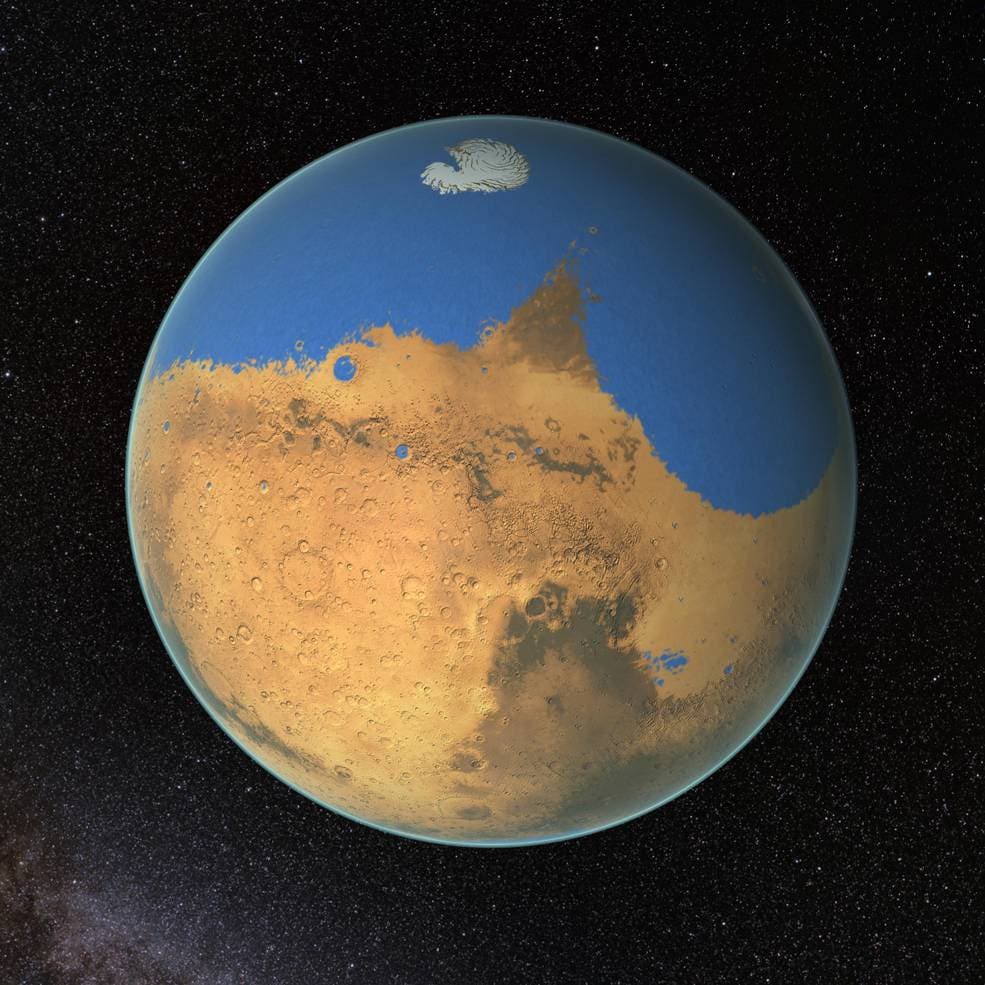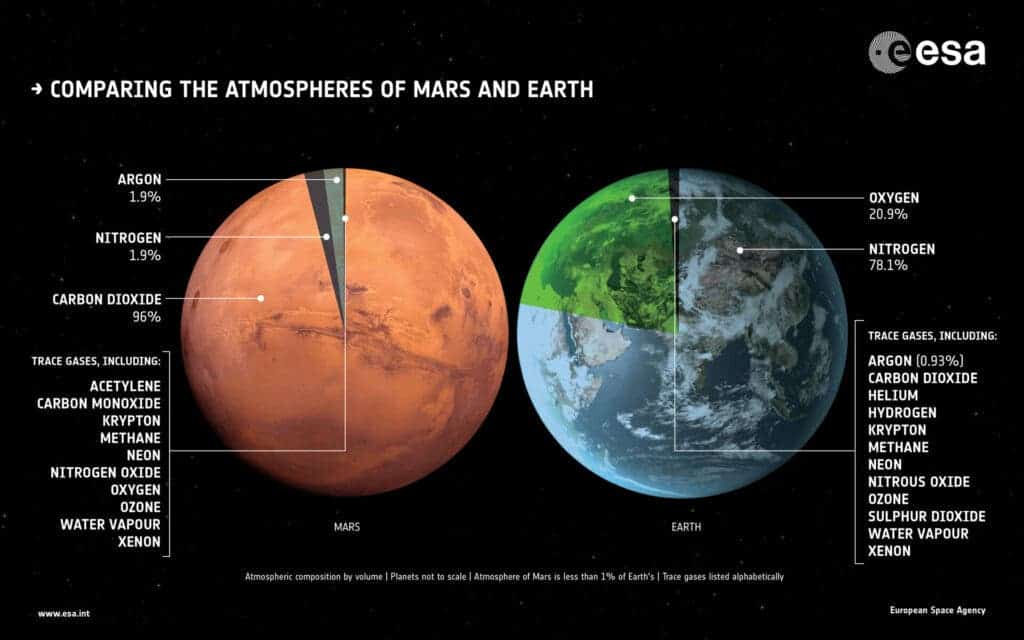A new study has revealed the detection of water in the upper atmosphere of Mars for the first time. The discovery gives scientists a good idea of the mechanism that is currently stripping the Red Planet of its water.
The surface of Mars is cold and dry —bereft of liquid water — but this wasn’t always the case. Studies of the Martian surface have discovered the tell-tale tracks of long dry ancient rivers and sedimentary deposits that indicate lake beds into which water once flowed. This poses the question of how the Red Planet lost its liquid water?
A study published in the journal Science suggests a new mechanism that could have driven Mars’ water loss. A team of astronomers has used data collected from Mars’ atmosphere by NASA’s Neutral Gas and Ion Mass Spectrometer on the Mars Atmosphere and Volatile Evolution spacecraft (MAVEN) to discover water in the planet’s upper atmosphere.
“For the first time, we have seen water in the upper atmosphere of Mars, at around 150 km above the surface. Other scientists have previously observed water in the middle atmosphere,” Shane Wesley Stone, a PhD. Candidate in Planetary Sciences at the Lunar and Planetary Laboratory, University of Arizona, and one of the paper’s authors tells ZME Science. “Water in the upper atmosphere is quickly destroyed and can escape to space, which is why our observations of water in the upper atmosphere are significant.”

Water transported to the upper atmosphere of Mars is converted to atomic hydrogen, which is then so-light that it is lost to space. This process could have been driving Mars’ water loss for billions of years. Water had previously been detected in the lower atmosphere, where scientists believed it was confined, but this is the first detection of water in the upper atmosphere, which caught the team by surprise.
“We did not know that water makes it all the way to the upper atmosphere, so we did not know how important this upward transport of water is to the escape of hydrogen to space and thus to water lost from Mars,” Stone says, explaining that water higher in the atmosphere would be broken down much more rapidly than happens closer to the martian surface. “Water which makes it to the upper atmosphere is destroyed in about 4 hours. This destruction of water would be ten times slower in the middle atmosphere, where most of the products of this destruction would be transported downward back toward the surface.”
Rising Damp: How Does Water Make its Way to Mars’ Upper Atmosphere?
Stone explains that the team is not yet certain what processes are lifting water to Mars’ upper atmosphere, but their study has yielded some good clues as to what may be the major players in this phenomenon.
“We see a seasonal trend in the upper atmospheric water abundance,” says the planetary chemist. “During summer in the southern hemisphere, the water abundance in the upper atmosphere is largest. During summer in the northern hemisphere, the water abundance in the upper atmosphere is smallest but is still significant.”
Stone explains that this seasonal trend is caused by two things. Firstly, during southern summer, Mars is closer to the Sun than it is during the rest of the Martian year. Secondly, this is also the season of dust storms on Mars. He adds: “Relatively close proximity to the Sun and dust storms both lead to heating in the atmosphere, which leads to greater transport of water to the upper atmosphere.”
The researcher points to a massive Martian dust storm that occurred in 2018 as being a major contributing factor to water in the upper atmosphere. The storm was first spotted by NASA’s Mars Reconnaissance Orbiter (MRO) on May 30th 2018 and by June of that year, it had grown to a planet encompassing event.
“Dust storms lead to a sudden splash of water into the upper atmosphere: during the global dust storm of 2018, the water abundance in the upper atmosphere increases by 20x relative to the nominal seasonal abundance,” Stone says. “Smaller surges of water are observed during regional dust storms that occur every Mars year of 687 days. Global storms occur about once every 10 Earth years.”
The team believe that water is moving upward past what planetary scientists call the hygropause — a cold layer in the atmosphere at which water condenses from vapour to liquid, forming clouds. “This because, as we and other scientists have found, the Martian hygropause is not as efficient at trapping water close to the surface as the hygropause on Earth,” Stone says. “The hygropause on Mars is not as efficient because it is too warm: when Mars is closest to the Sun and when dust storms occur, heating caused by these processes warms the hygropause, allowing water to move upward.”
The mechanism their finding reveals is currently the main way that Mars loses water, but Stone points out that this likely wasn’t always the case.
The Changing Picture of Water Loss on Mars
Water transported to Mars’ upper atmosphere by seasonal effects and dust storms where it is broken down to hydrogen and then lost to space is currently the predominant mechanism of water loss on Mars, but the team says this is only because of the Red Planet’s current environment. The water loss mechanisms that have proceeded for billions of years were likely different in the past in terms of both dominance and the speed at which they proceed.
“This process we describe is an important factor in Martian water loss today. However, this water could only be transported to the upper atmosphere relatively recently, over the last billion years or so,” Stone says. “Much of Mars’ atmosphere was lost to space before this time, leading to the weak hygropause which allows water into the upper atmosphere. All escape processes we observe today were likely faster in the past.”

The team reached this conclusion due to the fact that when all the water loss rates of the present-day escape processes are summed, their current escape rate is too slow to explain all the water loss that scientists know must have occurred over the last few billion years.
“We know that over 4 billion years, Mars lost about 66% of its atmosphere to space,” Stone explains. “If we talk about water specifically, Mars has lost 10s to 100s of meters of a ‘global equivalent layer’ of water — equivalent to spreading all of the water lost by Mars over its surface to form an even layer and then reporting how deep this layer would be.”
The process the team describe is responsible for the loss of 44 cm of H2O over the last billion years, and global dust storms are responsible for the loss of an additional 17 cm on top of this over the last billion years.
“In the present epoch, during most of the Martian year, this process we describe is just as important as the ‘classical process’ — the basic process scientists thought responsible for the transport of hydrogen to the upper atmosphere since the first work on this topic in the early 1970s,” Stone says. “During global storms, this water which makes it to the upper atmosphere produces 10x more escaping hydrogen than does the classical process.”
Big Surprises and Future Investigations
Stone describes that the next steps for this research involve figuring out exactly how important this new water loss mechanism has been throughout the history of Mars.
“Extrapolating back over billions of years is extremely difficult and doing it correctly takes time. We still need to understand better the specific transport processes responsible for delivering this water to the upper atmosphere,” he says, adding that the team’s findings came as something as a shock even to them. “The entire project was a huge surprise to us: we were surprised to see water this high in the atmosphere, we were surprised to see the seasonal trend in the water abundance, and we were surprised by just how big an effect the global dust storm has on the upper atmospheric water abundance.”

Researching water loss from Mars is likely to be an important step in understanding how abundant water is throughout the Universe, as Dimitra Atri, a researcher from the Space Science at NYU Abu Dhabi (NYUAD), recently told ZME Science: “Since it is extremely difficult to observe the escape process in exoplanets, we are planning to study this phenomenon in great detail on Mars with the UAE’s Hope mission.”
Thus, this type of study could tell us how unique Earth is in terms of the possession of liquid water in the Universe. Something that could, in turn, tell us about the chances of life on exoplanets.
“Mars used to look like Earth: warmer and wetter with a thick atmosphere and abundant liquid water on its surface,” Stone concludes. “But over the history of the solar system, Mars’ water was lost to space, leaving behind the cold, dry, red planet we see today. Regardless, Mars will be the next planet on which humans step foot.”
S.W. Stone; R.V. Yelle; D.Y. Lo, et al, [2020], ‘Hydrogen escape from Mars is driven by seasonal and dust storm transport of water,‘ Science.


